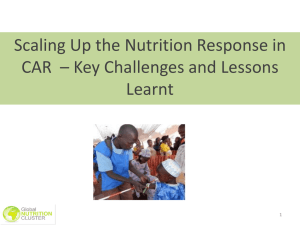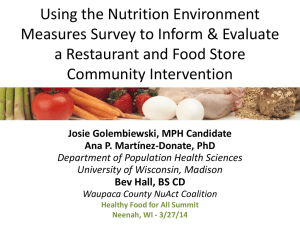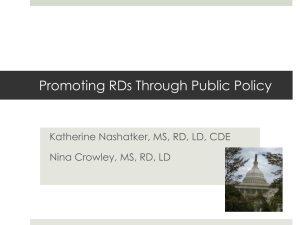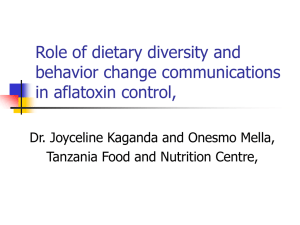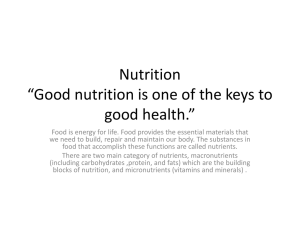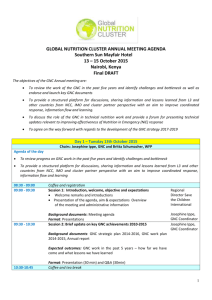South Sudan - Nutrition Cluster
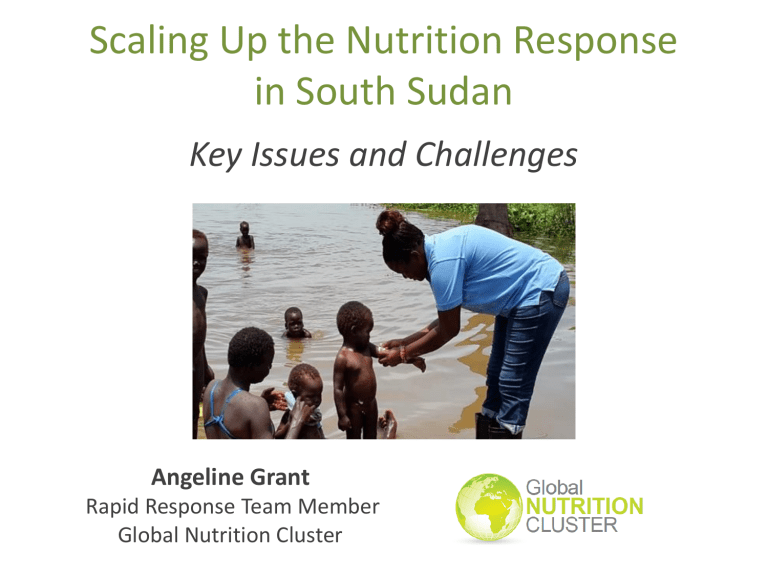
Scaling Up the Nutrition Response in South Sudan
Key Issues and Challenges
Angeline Grant
Rapid Response Team Member
Global Nutrition Cluster
Needs Assessment and Analysis
2
Issues and challenges faced in South Sudan during assessment and analysis
• Lack of systematic approach to nutrition assessments pre-crisis led to the development of under-informed CRP in Jan 2014
• Limited NI available to determine needs and inform IPC
• Recommended: nutrition surveillance system be established, NI TWG be strengthened SSSS, integrate nut into FSMS, increased capacity
• Caseloads revised mid-May with review of CRP large jump in targets
• On-going county-level needs analysis conducted through:
Cross-sectional nutrition surveys validated through NITWG and used to inform IPC analysis
County-level response analysis through Nutrition Response Matrix
IRNAs, rapid response mission data & RNAs qualitative and quantitative data
Programme data (“hotspots” for admissions/increased caseloads)
3
Assessment and analysis in South Sudan –
Key points for discussion
• How much data is needed to justify scale-up? data vs. response?
• Difficulties in analyzing programme coverage data to payam level
• Balance between need to rapidly deliver representative anthropometric data and longer time periods needed to collect mortality data
• Carrying out assessments in midst of L3 requires dedicated support and capacity-building initiatives
• Challenges in finding partners able to carry out assessments in priority locations, not their areas of intervention
• Timely turn-around for validation of results and large-scale dissemination
• Low availability of health, WASH and GFD data to feed into analysis
4
Strategic Response Planning
5
How was nutrition cluster strategic planning developed in South Sudan?
• CRP developed in Jan 2014 (Jan-June 2014) to guide nutrition response crisis-affected states, but limitations
• CRP revision, May 2014 needs analysis, caseload determination, targets, cluster strategic objectives and indicators, cluster operational priorities, priority interventions and cross-cutting themes
• Nutrition Cluster Response Matrix, June 2014 operational analysis of the response
• South Sudan Updated Nutrition Cluster Response Plan,
July 2014 builds on the Nutrition Cluster strategy defined during May 2014 CRP review
6
Strategic Response Planning in South
Sudan Issues and Challenges
• Tying macro-level strategy with concrete, operational priorities and actions
• Need for stand-alone logistics strategy for nutrition cluster in South Sudan?
• Improving transparency in prioritisation process particularly with regards to inter-sectoral deployment of assessment/mobile response teams
• New programming strategies such as expanded criteria/simplified protocols hampered by low levels of buy-in at country level and lack of resources
• Inter-sectoral linkages easy to plan strategic areas for collaboration but operational joint programming requires further partner engagement and leadership
7
Resource Mobilisation
8
Financial Resource Mobilisation – Issues and Challenges
• Nutrition response req initially set at $83,267,835 in Jan 2014 - May revised up to $131,000,000 (42% funded according to FTS)
• Funding gaps remain, impacting scale-up in a complex situation with extreme needs
• Increased level of donor interest but operational costs extremely high
• Clear articulation of extra supply and logistics requirements on a stand-alone basis?
• Capacity to quickly absorb funding is limited
• Some inter-sector approaches may not always be most appropriate for nutrition sector heavy focus on mobile teams/mobile responses
9
Resource Mobilisation: SUPPLY
10
Supply
• Supply requirements estimated by pipeline managers requirements to take into account revised caseloads May
‘14
• Concerns with stock-outs led cluster to instigate a twoweek deadline for requests with pipeline managers
• Regular pipeline updates at cluster meetings
• New reporting format for supplies implemented UNICEF
• Priority for nutrition supplies increased to extremely high priority by logistics cluster
• Joint WASH-health-nutrition supply mechanism established for Bentiu
11
Supply – Issues and Challenges
• Could the determination of supplies best been conducted at cluster level in conjunction with pipeline manager + other independent pipelines?
• Lack of pre-positioning meant re-supply became an issue, even when supplies available in central locations Low visibility of pipeline at state level
• Reporting of supplies by certain partners poor in first 6 months of year leading to disagreements on allocation vs. consumption
12
Supply – Issues and Challenges
• Low visibility of commodities further down the line (ETAs 2-3 months max)
• High dependence on ETA because of low levels of buffer stock
• Focus on conflict-affected states sometimes meant discrepancies at other levels/states
• Dependence on Juba as central hub vs. Rumbek where majority of logistics cluster air assets are stationed
• Cluster pipeline updates remained too general bilateral meetings chaired by Cluster Coordination Team between organisations and pipeline managers on specific areas/cases better mechanism for addressing bottlenecks?
13
Resource Mobilisation:
HUMAN RESOURCES
Human Resource Capacity – Issues and challenges
• Capacity mapping of nutrition partners conducted April 2014
Demonstrated need to have increased capacity, particularly international staff to expand programmes sufficiently quickly
• Capacity-building initiatives underway and technical capacity-building available through one partner as a stand-alone activity
• Turn to non-traditional nutrition actors to increase coverage and uptake
implications for capacity-building and quality
• Increasing capacity-building initiatives in midst of L3 requires, dedicated, external support
• Majority of partners express difficulties in recruiting for expatriate nutrition positions for South Sudan
• Insecurity and ability to maintain teams in deep field locations
• Heavy reliance on surge support with resulting high turnover of staff
15 and loss of institutional memory
Implementation and Monitoring
16
Implementation – Issues and challenges
• Issues related to lack of logistical support, insecurity, lack of physical access, fragile pipelines, and lack of qualified staff have curbed timely scale-up of nutrition programming in South Sudan
• Funding has been made available but situation requires larger contributions to address major logistical, HR and supply challenges in an effective manner
• Management of humanitarian space add. partners for existing partners
• Capacity of organisations to rapidly scale-up to new areas
• Need to strengthen IYCF-E programming and sensitize humanitarian community and donors on its importance
• Inter-sectoral programming is apparent in certain locations but focus to be extended to other areas of particular nutrition vulnerability
• Partner programming components may demonstrate some mechanisms of AAP but need to be developed and more widely disseminated
17
South Sudan achievements as of 11 September 2014
Monitoring of the response
• In mid-May, the targeted caseloads jumped to 176,283 for SAM and 420,000 for MAM “catch up” annual projected caseload
• Reporting and monitoring system may underestimate achievements but by how much?
• Reporting and monitoring of certain components of response are lacking (IYCF, MN)
• Monitoring of achievements starting to impact programme decision-making but needs to be improved
• Programme database cumbersome and analysis not programmed
• No reporting at site level revision of database on-going
19
Monitoring of coordination
• Initial lack of coordination capacity and turn-over of staff disruptive to partners
• ToR for Co-coordinator role not very clear and currently being reviewed
• Coordination with sub-national level not formalised
• Cluster Coordination Performance Monitoring exercise conducted in April 2014 to be reviewed at end of year given enhanced coordination capacity now in place?
20
Thank You
Questions?
21
